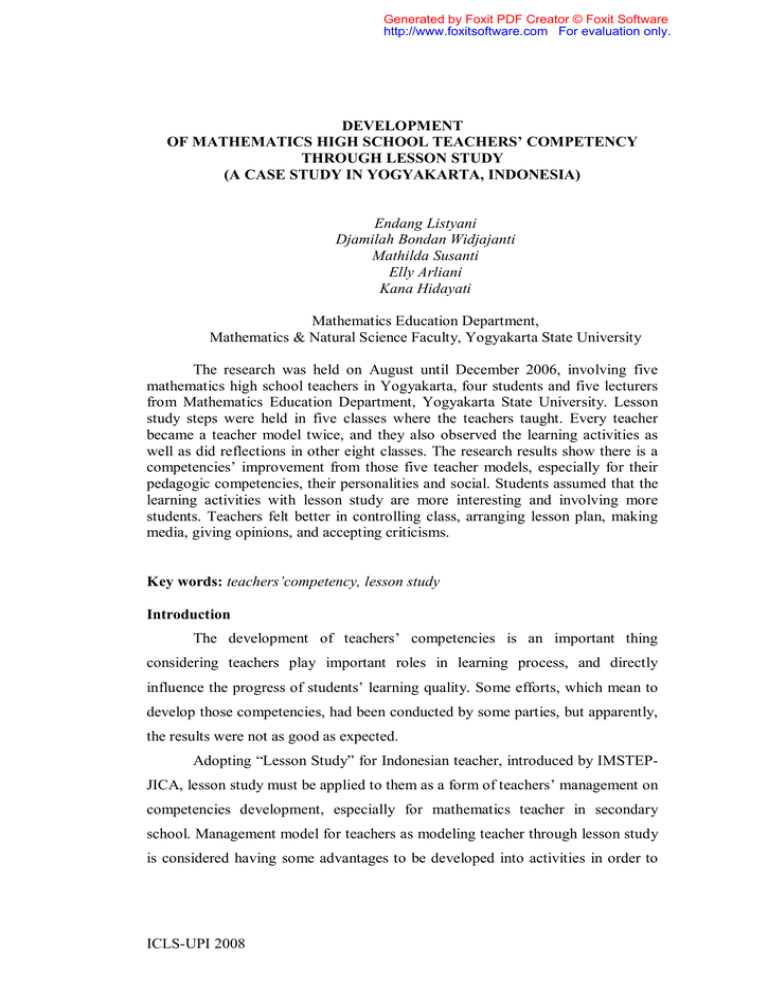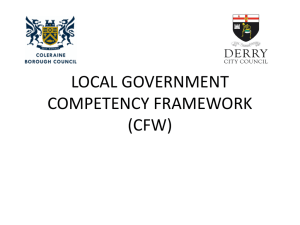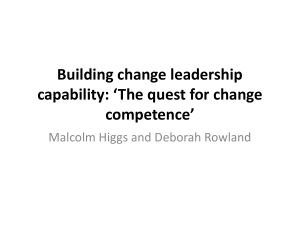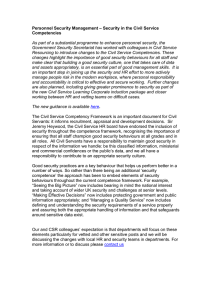DEVELOPMENT OF MATHEMATICS HIGH SCHOOL TEACHERS’ COMPETENCY THROUGH LESSON STUDY
advertisement

Generated by Foxit PDF Creator © Foxit Software http://www.foxitsoftware.com For evaluation only. DEVELOPMENT OF MATHEMATICS HIGH SCHOOL TEACHERS’ COMPETENCY THROUGH LESSON STUDY (A CASE STUDY IN YOGYAKARTA, INDONESIA) Endang Listyani Djamilah Bondan Widjajanti Mathilda Susanti Elly Arliani Kana Hidayati Mathematics Education Department, Mathematics & Natural Science Faculty, Yogyakarta State University The research was held on August until December 2006, involving five mathematics high school teachers in Yogyakarta, four students and five lecturers from Mathematics Education Department, Yogyakarta State University. Lesson study steps were held in five classes where the teachers taught. Every teacher became a teacher model twice, and they also observed the learning activities as well as did reflections in other eight classes. The research results show there is a competencies’ improvement from those five teacher models, especially for their pedagogic competencies, their personalities and social. Students assumed that the learning activities with lesson study are more interesting and involving more students. Teachers felt better in controlling class, arranging lesson plan, making media, giving opinions, and accepting criticisms. Key words: teachers’competency, lesson study Introduction The development of teachers’ competencies is an important thing considering teachers play important roles in learning process, and directly influence the progress of students’ learning quality. Some efforts, which mean to develop those competencies, had been conducted by some parties, but apparently, the results were not as good as expected. Adopting “Lesson Study” for Indonesian teacher, introduced by IMSTEPJICA, lesson study must be applied to them as a form of teachers’ management on competencies development, especially for mathematics teacher in secondary school. Management model for teachers as modeling teacher through lesson study is considered having some advantages to be developed into activities in order to ICLS-UPI 2008 Generated by Foxit PDF Creator © Foxit Software http://www.foxitsoftware.com For evaluation only. increase teachers’ competencies, like pedagogic competence, professional, personality, and social competence. Through lesson study steps, including plan-do-see, it is ensured that there will be a learning process from and for each member of lesson study team, so directly or indirectly, it can increase their competencies. Because learning process through lesson study in Indonesia is relatively new, evaluation for its effectiveness, especially its impact towards the progress of teachers’ competencies, is absolutely needed. Based on those statements above, this research is carried out. Problem to be solved through this research is whether lesson study can increase secondary teachers’ competencies in pedagogic competence, professional, personality, and social competence. Specifically, this research is aimed to: (a) evaluate lesson study activities; and (b) get materials to arrange recommendation about good mathematics teachers’ management. Theoretical Study According to PP RI No. 19 Tahun 2005 about National Education Standard (Peraturan Pemerintah RI No. 19 Tahun 2005 tentang Standar Pendidikan Nasional), which includes standards of teacher and education staffs, the main roles of teachers as a learning agent require four competencies. They are pedagogic competence, professional competence, personality competence, and social competence. Based on explanation above, it concludes that pedagogic competence relates with capability to carry out learning activities, while professional competence relates with capability to fulfill teachers’ functions and main tasks which is fit with their skills. Personality competence relates with capability to manage their selves as an adult and social competence relates with capability to interact with society. Facing those requirements, they need some activities that can be such a learning forum for them as a mathematics teacher. One of these activities is lesson study. According to Stigler and Hiebert, cited in Sparks (1999), 2 Generated by Foxit PDF Creator © Foxit Software http://www.foxitsoftware.com For evaluation only. ‘Lesson study is a collaborative process in which a group of teachers identify an instructional problem, plan a lesson (which involves finding books and articles on the topic), teach the lesson (one member of the group teaches the lesson while the others observe), evaluate and revise the lesson, teach the revised lesson, again evaluate the lesson, and share the results with other teachers’, Whereas according to Lewis (2001), “Lesson study is best known in the US as way to polish classroom lessons. But Japanese educators see it more broadly – as way to learn about subject matter, students, and teaching: as a way to bring their educational vision to life in the classroom; and a way to fuel system-wide improvement”. Same with both statements above, Friedkin (2005) says that “Lesson study is a process in which teachers jointly plan, observe, analyze, and refine actual classroom lessons called “research lesson”, whereas Hiebert’s opinion written by Cerbin and Kopp (2006) states that: ‘Lesson study is a teaching improvement and knowledge building process those origins in Japanese elementary education. In Japanese lesson study teachers work in small teams to plan, teach, observe, analyze, and individual class lesson, called research lessons’. Research Methodology This research is a case study and the subjects are five mathematics high school teachers in Yogyakarta, consist of a teacher from SMA Negeri 2 Yogyakarta, a teacher from SMA Negeri 5 Yogyakarta, two teachers from SMA Negeri 7 Yogyakarta, and a teacher from SMA Negeri 10 Yogyakarta. Research activities, including planning, implementation, and evaluation, had been held since August until December 2006. The instruments used are observation sheets, interview guide, questionnaire, and written test. Implementation of Lesson Study Lesson study, which was conducted in four state high schools in Yogyakarta, involved five mathematics teachers, four students of Mathematics Department, which was collecting data for paper, and five lecturers from Mathematics Education Department, Yogyakarta State University. 3 Generated by Foxit PDF Creator © Foxit Software http://www.foxitsoftware.com For evaluation only. The activities consisted of three parts; planning, implementation and observation, and reflection. Every teacher became a teacher model twice, and they also observed other members’ learning process eight times during the lesson study. Here are the outlines as follow. It stated by making lesson study team, then they compared their perception each other. Next activity was listing common mathematics learning problems usually faced. From this meeting, it concluded that topics discussed in lesson study are: (1) probability, especially rule of multiplication, permutation, and combination; (2) trigonometry formulas, especially cosine law for sum and difference of two angles; and (3) Circle, especially circle equation and tangent. These are difficult materials to talk. Besides, learners’ interaction could not happen naturally. After the topics decided, next activities were discussing learning instruments, involving lesson plan, students’ worksheet (LKS), media, and evaluation instrument. It started by expressing teachers’ idea about lesson plan which would be applied, by taking teachers’ problems and experience into consideration. The team examined it carefully, then gave suggestion and revised the plan. Based on chosen learning approach, by considering the importance of mathematics problem-solving skill in order to make learners thought logically and critically, problem solving approach was chosen. The problems had been discussed deeply during making lesson plan. But considering teachers’ limited time to make innovative and various media, students involved in this research helped teacher making comics, discussion cards, and students’ worksheet which was more interesting than the media used before. Five teachers used group discussion method during learning process. The purpose was to give more chances for students to be actively participated in class activities. Hopefully, there would be communication and interaction between members in the group, so students which still did not understand could ask their friends inside it. Reflection was applied soon after learning ended. It began with reflection form teacher model. Generally, this time was used to explain about students’ 4 Generated by Foxit PDF Creator © Foxit Software http://www.foxitsoftware.com For evaluation only. characteristics in his/her class, and to express what she thought and felt. Some teachers said that they felt quite nervous when they were observed while they were teaching. They also thought that could not implement all plans completely, especially because of inaccurate time prediction. After he/ she expressed it, it continued by suggestion giving from teacher observer. Generally, every teacher observer gave suggestion based on what they observed. After session one ended, they met again to make second lesson plan. Each teacher model had prepared its draft for current topic. Then it was discussed in forum. In second learning activities, five teachers implemented the learning based on lesson plan. In outline, observer assessed that second learning was better than the first one, especially students’ participation in class discussion. Based on questionnaires given to students, statement learning which is carried out involves students to participate more got positive responses (“agree” or “extremely agree”) from students, with percentage is more than 86% for each teacher. Other statements getting high rate were: (1) teacher-students relationship become more harmonious, (2) students get more attention, (3) teacher gave more feedback, and (4) materials are conveyed systematically. Besides, there was statement which got responses “agree” or “extremely agree” by less than 50% students, that is relationship of this subject to other subject frequently happened. Based on interview with these five teachers, they got advantages from this lesson study. Those are: (1) Arranging lesson plan together gave them broader knowledge about approaches, methods, and media; (2) they got inputs from other teachers about class management; (3) attended by teacher observer, students, and lecturer from Mathematics Education Department, Yogyakarta State University, they tried to prepare everything and perform better. Based on interviewing students from each teacher, generally students felt that teachers gave more attention (came closer during group discussion and gave directions) during class activities. The media used was more interesting than before. Generally, observer saw that students’ preparation and enthusiasms was good enough. Based on observation, things to be worried will disturb students’ attention, like presence of many people (other teachers, lecturers, students, and 5 Generated by Foxit PDF Creator © Foxit Software http://www.foxitsoftware.com For evaluation only. cameraman), was not happened. Several students or groups looked like there was nobody in the class except them and their teacher. According to explanation above, especially for those who related with implementation of lesson study, it was not adequate enough for teachers to be evaluated about progress of their competencies. Nevertheless, several facts from questionnaires, interview, and observation could prove that progress. Here is data related with pedagogic competence, especially in method used aspect. For about 66.66 % - 83.87 %, students “agree” or “extremely agree” that learning activities is more interesting; and 86.08% - 100% they “agree” or “extremely agree” that learning which is carried out involves students to participate more than before. This showed that teachers’ understanding towards interesting learning and the importance of students’ participation had increased. Based on interview, after following lesson study, teacher model could manage his/her class better, arrange lesson plan better, and know how to develop media better. According to documentation, there is progress in quality of lesson plan, media, and exercises used. About professional competence, result of their pre-test and post-test showed that only third and fourth teachers showed progress in it, although it was insignificant. Likely, it was caused by: (1) limited time for test, and (2) the difficulty rate of test. Based on questionnaires, in organization of material conveyance aspects, positives responses in statement more systematically material conveyance got high percentage (69.44 % - 87.10 %). But in the use of contextual problem is getting more, the percentage is in sufficient category. For this lesson study in fourth school, it got 52.77 %, indeed. For statement relationship of this subject to other subject frequently happened, it got 47.95 %, 48.05 %, 56.45 %, and 44.43 % successively listed from the first school to the fourth school. Thos low percentage maybe caused by limited time for carrying these activities. Examining result of questionnaires and tests, by following lesson study for four months, it could not be concluded that there was any progress in professional competence. But, indicator of this could be found when teachers discussed about revising lesson plan. If it was compared with first discussion, teachers had 6 Generated by Foxit PDF Creator © Foxit Software http://www.foxitsoftware.com For evaluation only. analyzed lesson plan more carefully and critically in the second one, including analyzed the possible answers for the given problems. About personality competence, based on questionnaires’ result, positive responses for two aspects which were regarded as personality competence had rate for about 69.86 % - 97.44 %. This meant that progress of personality competence could be observed directly. The facts that most of students (more than 75 %) gave them towards teachers’ empathy towards students, especially for the statements: (1) students get more attention; (2) teacher-students’ relationship become more harmonious, (3) teacher’s efforts to actively involve students into class discussions increase, could be considered as a prove of that progress. Based on questionnaires’ result, in social competences, there were various positive responses for three aspects of social competencies between teacher and students in range of 44.43% until 91.90%. Also there were progress in frequencies of conveying opinion and suggestion from five teacher models. If in first meeting there were some teacher models that were not able to give opinion and suggestion to others, in second meeting it changed. Almost all of teacher models gave their opinions and suggestions, both during making lesson plan and reflection frequently. Based on interview results, five teacher models felt that they were more open-minded in receiving criticisms and suggestions from other teachers after lesson study. It showed that one of lesson study purpose, which was open-minded to receive criticisms and suggestions in order to improve learning process, had stood in their mind. Progress of teachers’ competencies gave implication towards progress of learning process’s quality, especially improvement of teachers’ understanding about how students learned and how to help them increased their knowledge. This was matched with some statements from experts, like Richardson (2004). He states that …Lesson study: Teachers learn how to improve instruction. And added by Lewis in Stepanek (2001) that: “…the most powerful part of lesson study is that you develop the vision to see children. You’re really watching how children are learning, and learning to see things that you didn’t see before; their thinking and their reactions.” 7 Generated by Foxit PDF Creator © Foxit Software http://www.foxitsoftware.com For evaluation only. Conclusion Although lesson study had been carried out just in four month, from discussion above, we conclude that there had been progress of five competencies after following it, especially in pedagogic competence, personality competence, and social competence. In pedagogic competence, learners said that learning activities became more interesting and involved more students. Generally, teacher model could manage class better, made lesson plan better, and know how to develop media better. The progress of personality and social competence could be seen from students’ positive responses: (1) students get more attention; (2) teacher-students’ relationship become more harmonious, (3) teacher’s efforts to actively involve students into class discussions increase. Minimally, lesson study made teachers model increase their communication skill and become open-minded to receive criticisms and suggestion from other teachers. Limitation This research had been conducted among limited time and funds, so that: (1) teachers were chosen deliberately, only five teachers from four high schools; (2) time for research was only about four months, so that they got chances for being teachers model only twice; (3) instruments used to measure teachers’ competencies, although it had been presented in seminar, had not been implemented yet in pilot project. Implication from this limitation is this research can not be implemented for all mathematics teachers. But with all of these limitations, this research can be used as first reference about impact of lesson study towards progress of teacher competencies. Ideally, to increase teachers’ competencies more significantly, it has to be implemented continually. 8 Generated by Foxit PDF Creator © Foxit Software http://www.foxitsoftware.com For evaluation only. References Cerbin, W. & Kopp, B. (2006). Lesson Study as a Model for Building Pedagogical Knowledge and Improving Teaching, In International Journal of Teaching and Learning in Higher Education, 2006, Volume 18, Number 3, 250 – 257, ISSN 181-9129, Available online at http://www.isetl.org/ijthe/. Accessed 15th March 2006 . Friedkin, Shelley. 2005. What is Lesson Study?. Available online at http://www.lessonresearch.net/ . Accessed 20th December 2006. Lewis, Catherine. (2001).Lesson Study: Teacher-Led Improvement of Instruction, InThe CSP Connection vol 2, no 1, September 2001, Available online at http://www.humbold.edu/~jww12/LESSON%20STUDY. Accessed 10th March 2006 Richardson, Joan. (2004). Lesson Study: Teachers learn how to improve instruction. In Tools for School, February/March 2004, Available online at http://www. calread.net/document/S. Accessed 24th July 2006. Sparks, D.(1999).Using Lesson Study to Improve Teaching. Available online at http://www.nsdc.org/library/publicatioms/results/res11-99spar.cfm. Accessed 12th December 2006. Stepanek, Jennifer. (2001). Lesson Study: Teachers Learning Together, In A Math and Science Journal Northwest Regional Educational Laboratory, volume 2 number 2, Spring 2001. Available online at http://www.ncosp.wwu.edu/ Resources/ Summer2007PD/ . Accessed 10th December 2006. 9







